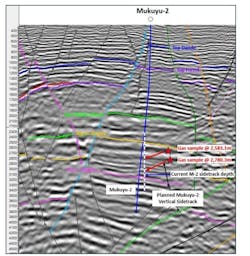Invictus Energy Ltd. discovered gas in the Mukuyu-2 sidetrack well in license SG 4571, Cabora Bassa basin, Zimbabwe. The discovery confirms Mukuyu as the first Triassic-age gas discovery in sub-Saharan Africa.
The Mukuyu-2 discovery is 7 km away and 450 m updip of the Mukuyu-1 well (OGJ Online, Oct. 31, 2023). The sidetrack intermediate total depth (TD) was called at 2,987 m measured depth (MD) towards the base of the Upper Angwa formation, based on indications from real-time logging while drilling (LWD) and mudgas data. Invictus performed an intermediate wireline logging run with the primary objective of obtaining hydrocarbon samples from Upper Angwa reservoirs.
Gas and fluid properties from the recovered samples will be confirmed following laboratory testing. No additional fluid samples were captured to preserve the wireline formation sampling tool and remaining sample chambers to interpret Lower Angwa hydrocarbon-bearing zones where thicker sandstone units were penetrated in Mukuyu-2. Wireline log interpretation calculates a preliminary net pay estimate of 13.9 m for the Upper Angwa, however, this estimate is still subject to further calibration of the logs with core and fluid data to determine appropriate net cutoffs and subsequent pay estimates.
Additional gross sands were intersected within the Upper Angwa gas leg but are below the current net reservoir cutoff. These intervals may have better reservoir development elsewhere in Mukuyu field and along with the refinement to the net pay criteria represents additional upside. Further appraisal and technical evaluation of log, core, seismic, and well test data is required to determine the full extent of the resource size.
Following the fluid sampling, 13 large volume sidewall core samples were recovered from priority points in the Pebbly Arkose and Upper Angwa which will be used to calibrate the wireline log data in post-well analysis.
The sidetrack will be deepened towards the planned TD in the Lower Angwa at about 3,400 m MD. The ultimate TD will depend on the intersection of sands anticipated based on the Mukuyu 2 logs and observations around the prevailing formation pore pressures.
The Exalo Rig 202 will drill ahead towards the sidetrack section TD at about 3,400 m MD through Lower Angwa reservoirs where multiple zones interpreted from logs to be hydrocarbon-bearing were intersected in Mukuyu-2. Following the conclusion of the drilling of the 8 ½-in. hole section, the sidetrack will be logged including wireline formation testing and fluid sampling.
Completion of the sidetrack will also allow the well to be suspended for future flow testing by running a 7-in. liner over this interval. This will provide the opportunity to drill, evaluate, and test the remaining portion of the Lower Angwa, below 3,400 m MD in the 6-in. hole. Over pressured gas bearing reservoirs were encountered in this interval in the original Mukuyu-2 wellbore.
Invictus secured a 2-year contract extension for rig to remain in the area for further drilling and well testing (OGJ Online, Dec. 1, 2023).
Cabora Bassa basin lies onshore in the Zambezi Valley in Muzarabani, 300 km northeast of Harare. Mukuyu field has a structural closure of over 200 sq km and independent estimates place Mukuyu resource at 20 tcf gas and 845 million bbl of conventional gas-condensate.
Invictus is operator with 80% interest.
About the Author
Alex Procyk
Upstream Editor
Alex Procyk is Upstream Editor at Oil & Gas Journal. He has also served as a principal technical professional at Halliburton and as a completion engineer at ConocoPhillips. He holds a BS in chemistry (1987) from Kent State University and a PhD in chemistry (1992) from Carnegie Mellon University. He is a member of the Society of Petroleum Engineers (SPE).

